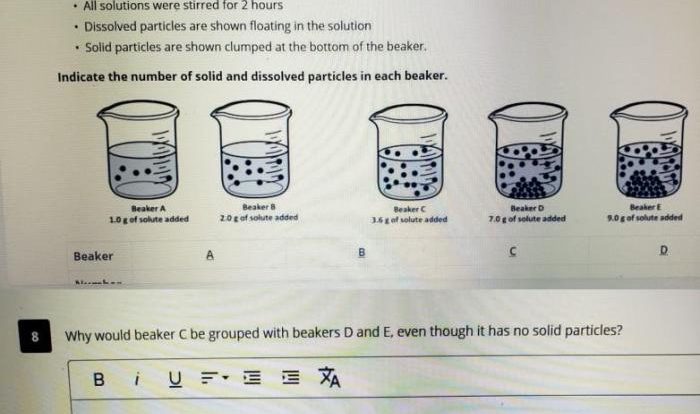In the realm of chemistry, mixed naming worksheet ionic covalent and acids stands as a cornerstone, guiding students through the intricacies of naming ionic and covalent compounds and acids. This comprehensive resource delves into the fundamental concepts of ionic and covalent bonding, providing a structured approach to understanding the rules and conventions governing the naming of these chemical entities.
As we embark on this journey, we will explore the distinct properties of ionic and covalent compounds, unravel the mysteries of acid nomenclature, and engage in hands-on exercises designed to solidify our understanding. Prepare to embark on an enlightening odyssey that will empower you to confidently navigate the world of chemical nomenclature.
Understanding the Nomenclature of Ionic and Covalent Compounds: Mixed Naming Worksheet Ionic Covalent And Acids
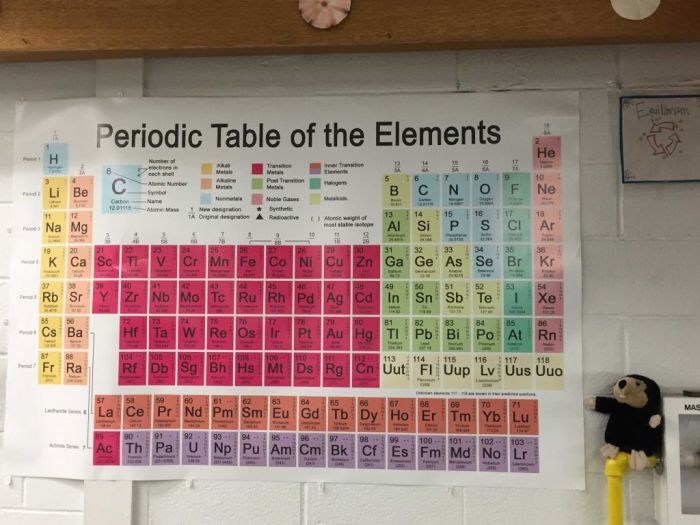
In chemistry, the nomenclature of compounds refers to the system of naming chemical substances. Understanding the nomenclature of ionic and covalent compounds is essential for effective communication and comprehension in the field of chemistry.
Ionic compounds are formed by the electrostatic attraction between positively charged ions (cations) and negatively charged ions (anions). The names of ionic compounds typically consist of the name of the cation followed by the name of the anion. For example, sodium chloride (NaCl) is an ionic compound composed of sodium cations (Na+) and chloride anions (Cl-).
Covalent compounds, on the other hand, are formed by the sharing of electrons between atoms. The names of covalent compounds are typically derived from the names of the elements involved. For example, methane (CH4) is a covalent compound composed of one carbon atom and four hydrogen atoms.
Rules for Naming Ionic and Covalent Compounds
- For ionic compounds, the name of the cation is typically written first, followed by the name of the anion.
- For covalent compounds, the name of the element with the higher electronegativity is typically written first, followed by the name of the element with the lower electronegativity.
- For ionic compounds, the charge of the cation is indicated by a Roman numeral in parentheses after the name of the cation.
- For covalent compounds, the number of atoms of each element is indicated by a Greek prefix before the name of the element.
Identifying the Type of Bonding
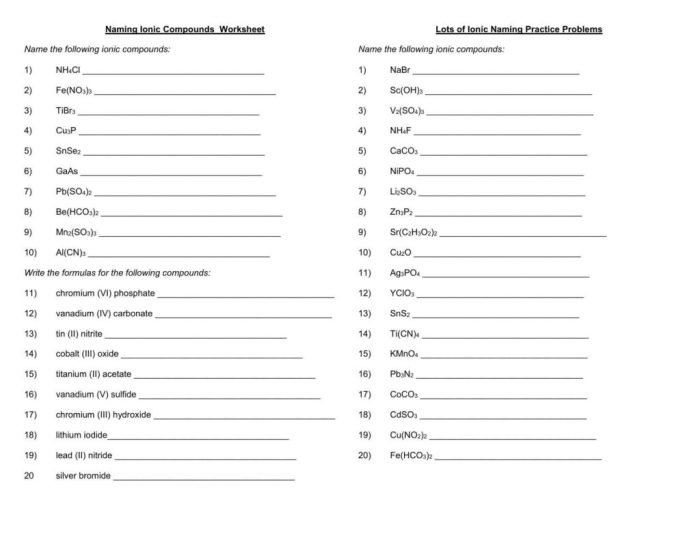
Ionic and covalent bonding represent two distinct types of chemical bonding. Understanding the properties of ionic and covalent compounds can help in determining the type of bonding present in a compound.
Properties of Ionic and Covalent Compounds
- Ionic compounds are typically solids at room temperature and have high melting and boiling points.
- Ionic compounds are good conductors of electricity when dissolved in water or melted.
- Covalent compounds can exist as solids, liquids, or gases at room temperature and have relatively low melting and boiling points.
- Covalent compounds are generally poor conductors of electricity.
Determining the Type of Bonding, Mixed naming worksheet ionic covalent and acids
The type of bonding in a compound can be determined based on its properties. If a compound is a solid with a high melting point, it is likely an ionic compound. If a compound is a liquid or gas with a low melting point, it is likely a covalent compound.
Additionally, the electrical conductivity of a compound can also provide clues about the type of bonding. If a compound is a good conductor of electricity, it is likely an ionic compound. If a compound is a poor conductor of electricity, it is likely a covalent compound.
Writing Chemical Formulas
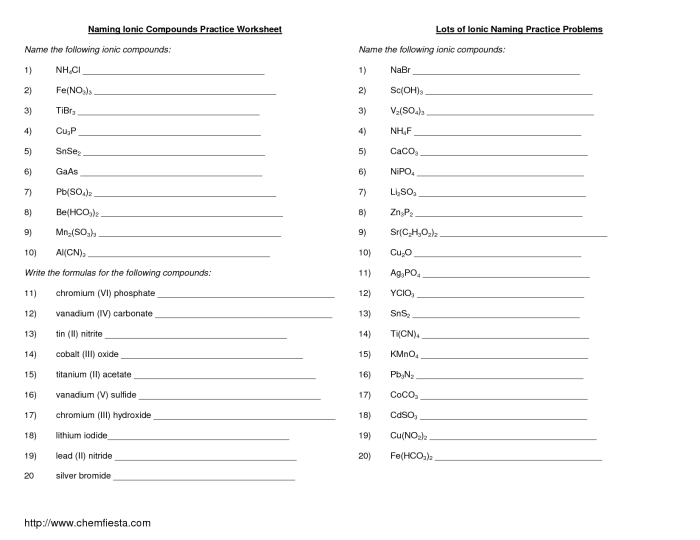
Chemical formulas are used to represent the composition of chemical compounds. Writing chemical formulas for ionic and covalent compounds involves different steps.
Steps for Writing Chemical Formulas for Ionic Compounds
- Determine the charges of the ions involved.
- Balance the charges of the ions by adjusting the subscripts.
- Write the chemical formula using the balanced subscripts.
Steps for Writing Chemical Formulas for Covalent Compounds
- Determine the number of atoms of each element present in the compound.
- Write the chemical formula using the correct subscripts.
Naming Acids
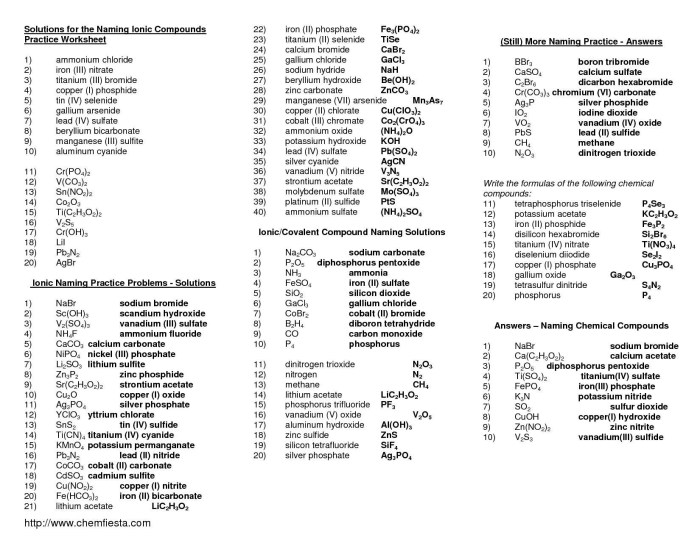
Acids are chemical compounds that donate protons (H+ ions) in water. Acids can be classified as either binary acids or oxyacids.
Binary Acids
Binary acids are composed of hydrogen and one other element. The names of binary acids typically end in “-ide.” For example, hydrochloric acid (HCl) is a binary acid composed of hydrogen and chlorine.
Oxyacids
Oxyacids are composed of hydrogen, oxygen, and one other element. The names of oxyacids typically end in “-ic acid” or “-ous acid.” For example, sulfuric acid (H2SO4) is an oxyacid composed of hydrogen, sulfur, and oxygen.
Frequently Asked Questions
What is the difference between ionic and covalent bonding?
Ionic bonding involves the transfer of electrons between atoms, resulting in the formation of charged ions. Covalent bonding, on the other hand, involves the sharing of electrons between atoms.
How do I determine the type of bonding in a compound?
The type of bonding in a compound can be determined based on its properties, such as solubility, electrical conductivity, and melting point.
What are the rules for naming ionic compounds?
Ionic compounds are named using the names of the constituent ions. The cation (positive ion) is named first, followed by the anion (negative ion).
